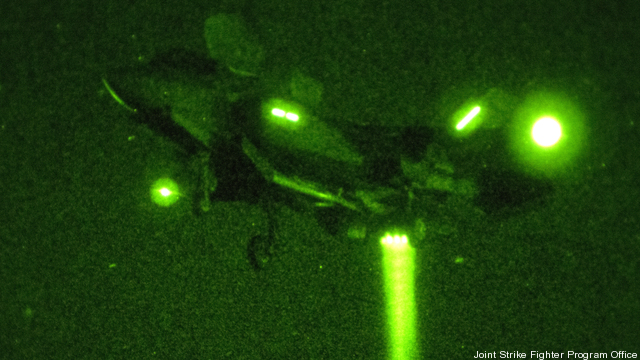F-35B Jump Jet Makes Its First Vertical Landing At Night (VIDEO)
Posted on
 The F-35 Joint Strike Fighter has had more than its share of ups and downs, but this week the jump-jet variant of the JSF had an up and down of historic significance: On April 2nd, a Marine Corps F-35B conducted the first ever short take-off and vertical landing that aircraft has ever done at night. In a flight at Patuxent River Naval Air Station, the famous test site nicknamed Pax River, Marine pilot Maj. C.R. Clift put the long-awaited aircraft through its paces after dark.
The F-35 Joint Strike Fighter has had more than its share of ups and downs, but this week the jump-jet variant of the JSF had an up and down of historic significance: On April 2nd, a Marine Corps F-35B conducted the first ever short take-off and vertical landing that aircraft has ever done at night. In a flight at Patuxent River Naval Air Station, the famous test site nicknamed Pax River, Marine pilot Maj. C.R. Clift put the long-awaited aircraft through its paces after dark.
The Marines have fought long and hard for a replacement for their venerable AV-8B Harrier jump-jet. Their sheer determination and outsize political clout have kept the F-35B going despite the fact that the vertical-landing variant is by far the most technically difficult to develop of the three F-35 models. (The Air Force’s F-35A and the Navy’s F-35C take off and land like any other aircraft).
With a jump jet, the Navy’s dozen “big deck” amphibious warfare ships become pocket aircraft carriers, able to conduct airstrikes on their own without waiting for the nuclear-powered supercarriers to show up. It was an amphib, the USS Kearsage (LHD-3), that launched the first strikes on Libya in 2011. But if the Harriers have to retire before the F-35B can replace them — or if the F-35B is cancelled — that pocket carrier capability goes away, and the amphibs are limited to launching helicopters and V-22 Osprey tilt-rotors.
Without jump-jets flying off amphibs, in turn, Marine Corps fighter squadrons aren’t doing anything their Navy counterparts don’t do, which raises the question of redundancy. As the Marine Corps’ critics put it, why does the Navy’s army need its own air force? The F-35B is the Marines’ answer to this question. That’s why this week’s test flight matters so much, not only for future battles overseas, but for the budget battles underway right now in Washington.
Subscribe to our newsletter
Promotions, new products and sales. Directly to your inbox.
